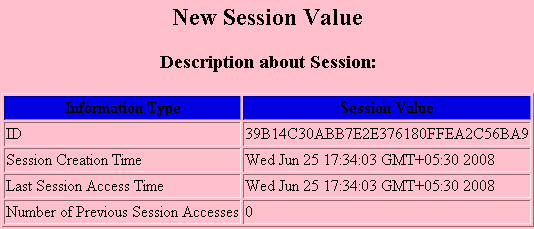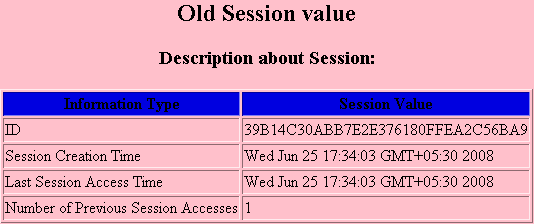Display session value Using Servlet
Sometime while developing web application it is necessary to interact with the different values of the Session object. In this example we will explore the different values of the Session object and then learn how to use it in our programming code.
You will learn how to find all the session related information like:
- getId. This method is used to find the identifier of the session which is unique.
- isNew. This method is used when find, whether session is newly created or preexisted. If session has never seen by user then this method return "true" but if session is preexisted then it return "false".
- getCreationTime. This method is used to find the creation time of session. To use of this method we can find the following details about session i.e. day, month, date, time, GMT(Greenwich Mean Time) and year will be displayed.
- getLastAccessedTime. This method is used to find the last accessed time of session. It returns the time, in milliseconds.
- getMaxInactiveInterval. This method returns the total time, in seconds, during which session remains active if user does not accesses the session for this maximum time interval. After this time the session will be invalidated automatically. A negative value indicates that the session should never timeout.
Here is the sample code for HttpSessionDisplay.java:
import java.io.*;
|
Here is the mapping of class file in web.xml.
| <servlet> <servlet-name>HttpSessionDisplay</servlet-name> <servlet-class>HttpSessionDisplay</servlet-class> </servlet> <servlet-mapping> <servlet-name>HttpSessionDisplay</servlet-name> <url-pattern>/HttpSessionDisplay</url-pattern> </servlet-mapping> |
Run this example by this url: http://localhost:8080/CodingDiaryExample/HttpSessionDisplay
Output:
In case of first time accessing of servlet the following session value will be displayed

In case of preexist session if user accessed the servlet then the following session value will be displayed.




